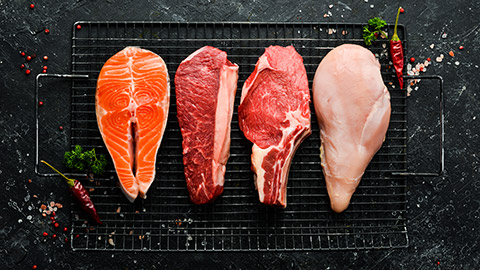Diet and exercise go hand-in-hand when it comes to achieving fitness goals. Diet plays an important role in achieving and maintaining weight goals, building muscle, and improving overall health and well-being.
As people become more health conscious, new dietary trends emerge including diets such as keto, paleo, and intermittent fasting. You may already be familiar with some of these. Understanding these trends and how they affect the body is important for you to know so you can help your future clients achieve their health and fitness goals.
In this topic, we will explore the following dietary trends:
- Fasting
- Paleolithic (paleo)
- Ketogenic (keto)
- Low FODMAP
- Vegan and vegetarian
- Raw food
Why is it important to know about dietary trends?
Knowing about dietary trends also allows personal trainers to make appropriate recommendations and modifications to their clients' nutrition plans. For example, a personal trainer may need to adjust a client's protein intake to support muscle growth or recommend carbohydrate intake before a workout to improve performance.
It's also important that as a personal trainer, you feel comfortable helping your clients navigate fad diets and misinformation about nutrition. By staying up to date on the latest dietary trends and research, you can provide clients with accurate and effective guidance for reaching their fitness goals.

Fasting is essentially a means of calorie deprivation. There are many types of fasting, but the most common are:
- Intermittent fasting: The most commonly followed intermittent fasting protocols are the 16/8 fast (16 hours of fasting/8 hours in which you can eat), and the 5/2 fast (eat normally for 5 days, then 2 days where calories are restricted to 500-600 cal).
- Eat stop eat: Eat normally most days but fast for 24 hours two days a week.
- Alternate day fasting: Eating one day, then not eating the next day.
- Ramadan fasting: A religious fast where food is only consumed when the sun is down.
- Warrior fasting: Fast all day, eat in a 4-hour window at night.
Scientific findings
The following information has been taken from a literature review by Horne et al (2015). This review looked at 275 articles from the internet. Of these, 118 were carried out on humans, only 27 were clinical trials. Out of all these studies, only 3 were robust randomised controlled clinical trials comparing intermittent fasting with standard diets. The results of these 3 trials were published in 5 articles.
The articles were completed with several scientific measures in mind including:
- Weight loss, fat mass reduction
- Metabolic, cardiovascular, and cognitive benefits
- Mood states tension, anger, confusion, and depression status
- Better blood glucose control
- DNA damage
- Blood pressure, total cholesterol, LDL cholesterol
- Blood triglyceride levels
- Weight loss/fat reduction
Fasting has shown clear evidence of benefits for weight loss and reduction of fat-free mass. The reasoning for this is quite simple - there are fewer calories consumed. Long periods without food also encourages the body to use fat as a fuel source.
Important metabolic and cardiovascular benefits have been reported in humans that deserve further consideration in therapeutic fasting trials, such as decreases in LDL (bad) cholesterol, triglycerides, and C-reactive protein (thought to impair the role of leptin).
Human growth hormone
Fasting has also been shown to substantially increase human growth hormone (HGH). HGH facilitates lipolysis (fat burn as fuel) and fatty acid release during fasting for use as energy. These elevated HGH levels ended shortly after feeding resumed, but as long as a fasting protocol was maintained, the benefit would continue.
Mood
A literature review by Fond et al. (n.d) looked at 92 studies on the effect of fasting on mood and found:
- Improvements in mood, sleep quality and concentration (after 8 days of modified fast)
- Increased endorphin production (feel-good hormones)
- Decreased pain sensation
- Reduction in depression symptoms (after 5 days)
It must be noted that many of these studies lacked controls and the author was forced to conclude that the absence of quality studies makes it impossible to say that fasting significantly improves mood or depression.
Any risks?

Britain's National Health Service reports the following potential negative side effects of fasting:
- Dehydration: Humans derive significant water content from the food they eat. A reduction in food would require an increase in water intake to offset this.
- Stress: Constant hunger signalling and a lack of glucose to the brain can cause increased stress on the body in the early stages of a fast. This has been shown to increase stress hormones (cortisol) and reduce sleep in the initial stages.
- Heartburn: Lack of food leads to a reduction in stomach acid. But smelling food or even thinking about it during fasting periods can trigger the brain into telling the stomach to produce more acid, leading to heartburn.
So what does all this mean?
Horne et al (2015) concluded that for fasting to be more than a weight-loss fad, a much better quality of scientific data is needed than is currently on offer.
While anecdotal enthusiasm for fasting is increasing, clinical relevance remains low because of insufficient human data, including almost nonexistent controlled trials and few clinical outcomes studies. That said there is some evidence to suggest that therapeutic fasting may provide substantial benefits for reducing clinical risk and therefore improve health markers such as cholesterol reduction and better glucose control. This warrants further study in this area. These studies should focus on the following questions:
- Does fasting actually cause improvements in metabolic health, cognitive performance, and cardiovascular outcomes over the long term?
- How much fasting is actually beneficial?
- Where is the balance between benefit and harm (of insufficient calorie intake)?
These, unfortunately, remain open questions as the vast majority of human studies of a fasting intervention were weight-loss studies. There is little to no evidence that fasting would have any beneficial effects on those in a healthy weight range. More robust research is required before this approach can/should be used as a mainstream diet option for improved health.
The skinny on fasting
Intermittent fasting appears to help with fat reduction and may improve health. However, substantial additional clinical research is needed before advocating its use for health purposes.

A paleo diet is based on foods similar to what might have been eaten during the Paleolithic era, which dates from approximately 2.5 million to 10,000 years ago. In its purest form, the paleo diet allows you to eat only those foods that humans ate when they first roamed the planet millions of years ago.
The following excerpt is from L Cordain's 2012 book "The Paleo Answer". It explains the basic premise of the paleo diet.
Origins of the paleo diet
Paleolithic refers to the period of history of the genus Homo, beginning more than 2 million years ago and continuing until about 10,000 years ago, i.e., up to the point where humans began to cultivate plants (grains) and animals (livestock).
In the Paleo era, people lived as hunter-gatherers, eating wild animal-source foods (lean meats, internal organs, bone marrow, but no dairy) and uncultivated plant-source foods (mostly fruits, non-grain, vegetables and nuts, but not legumes). The thinking goes that modern humans may more closely optimise core metabolism and physiology when they consume a diet more closely resembling our ancestral hunter-gatherer’s pre-agricultural diet (Frassetto et al., 2009.)
Issues with the modern diet
The modern diet differs from paleolithic-type diets, not only as a consequence of the agricultural and farming revolutions, but also as a consequence of the industrial revolution and, more recently, the fast food revolution.
The additions of these modern foods to the paleo diet could be the root cause of many of our current diseases such as: Atherosclerotic cardiovascular disease and its derivatives, insulin resistance and type 2 diabetes, metabolic syndrome, age-related conditions such as sarcopenia (muscle loss), arthritis and osteoporosis, hypertension and its associated issues, and some types of cancers.
Paleo foods
A controversial diet
Fad diets come and go, some gaining more traction within the public sphere than others. One of the most controversial diets in recent times is the paleo diet. The diet has been the subject of intense criticism by health professionals because of wellness bloggers’ and celebrity chefs’ exaggerated claims about its purported effects – e.g., that the palaeolithic diet could prevent or cure polycystic ovary syndrome, autism, mental illness, dementia, and obesity (Pitt, 2016.)
Published evidence
While proponents of the palaeolithic diet claim that it is evidence-based, there are only a limited number of controlled clinical trials comparing the palaeolithic diet to other diets. The following table is a summary of the literature from Pitt, 2016.
| Lindeberg et al (2007) | 29 patients; IHD and impaired glucose metabolism | RCT – Paleo versus Mediterranean-like diet for 12 weeks | Weight – no difference; Paleo – decreased WC, increased glucose sensitivity |
| Osterdahl et al (2008) | 14 healthy volunteers | Pilot | Paleo – mean weight loss of 2.3 kg, decreased WC 0.5 cm, improved SBP, increased CRP (non-significant) and significantly lacked calcium |
| Jönsson et al (2009) | 13 patients; T2DM | RCT – crossover, two consecutive three-month periods, Paleo versus diabetic-like diet | Paleo – improved HbA1c, DBP, lipid profile, weight, WC; no significant change in CRP |
| Frassetto et al (2009) | Nine non-obese, sedentary volunteers | Metabolically controlled – Paleo versus diet as usual | Paleo – improved SBP, DBP, arterial distensibility, insulin sensitivity, plasma lipids |
| Jönsson et al (2013) | 13 patients; T2DM | RCT – crossover, two consecutive three-month periods, Paleo versus diabetes diet | Paleo – increased satiety for energy, energy density and glycaemic load. Difficult to adhere to. |
| Boers et al (2014) | 34 patients; metabolic syndrome | RCT – two weeks, Paleo versus isocaloric diet based on Dutch Health Council guidelines | Paleo – decreased SBP, DBP and weight (1.32 kg); improved lipid profile. No change to intestinal permeability, inflammation, salivary cortisol |
| Whalen et al (2014) | University of Minnesota Cancer Prevention Research Unit data | Case controlled – incidence colorectal polyps, Paleo versus Mediterranean diet | Similar non-significant decreased incidence colorectal polyps |
| Mellberg et al (2014) | 70 patients; females who were obese and post-menopausal | RCT – two years, Paleo versus Nordic Nutrition Recommendations diet | Paleo – increased weight loss at six months, no difference at two years. Improved BP, CRP and lipid profile in both groups. No difference glucose/insulin both groups |
| Bligh et al (2015) | 24 healthy male volunteers | Acute, double-blinded, RCT – two different Paleo diets and WHO-based reference meal | No significant difference in glucose and insulin responses between different meals |
*Controlled human trials of the Paleolithic diet selected for review. Papers retrieved from Pubmed search for ‘Paleolithic Diet’ limited to ‘humans’ { (‘diet, paleolithic’[MeSH Terms] OR (‘diet’ [All Fields] AND ‘paleolithic’ [All Fields]) OR ‘paleolithic diet’ [All Fields] OR (‘paleo’ [All Fields] AND ‘diet’ [All Fields]) OR ‘paleo diet’ [All Fields]) AND ‘humans’ [MeSH Terms]}
CRP, C-reactive protein; DBP, diastolic blood pressure; IHD, ischaemic heart disease; Paleo, the Palaeolithic diet; RCT, randomised controlled trial; SBP, systolic blood pressure; T2DM, type 2 diabetes mellitus; WC, waist circumference; WHO, World Health Organization
Snapshot of findings
Looking at the studies as a whole, the palaeolithic diet was often associated with:
- increased satiety (regardless of caloric or macronutrient composition).
- improvements in body weight, waist circumference, blood pressure, and lipid profiles.
- however, the studies were short and underpowered.
- the strongest of the studies was by Mellburg et al (2014), who showed no long-term differences between participants on the palaeolithic diet and those on the control at 24 months.
Other considerations
Hard to stick at?
Adherence and palatability (taste) were common issues raised about the palaeolithic diet.
Glucose control
Some studies reported improvements in plasma glucose control (insulin), though some did not, including a high-quality, laboratory-controlled study by Bligh et al (2015) which showed no significant difference in glucose and insulin levels for the palaeolithic diet, compared with their reference diet.
Cost
When comparing the cost of the palaeolithic diet to the normal western diet, Pitt (2016) suggests that it is approximately 10% more expensive than an essential diet of similar nutritional value, which may limit the palaeolithic diet’s usefulness for those on a low income.
Calcium deficiency?
Calcium deficiency also remains a significant issue with the palaeolithic diet; the study by Osterdahl et al (2008) showed that the calcium intake of the paleo diet was about 50% of the recommended dietary intake. Uncorrected, this could increase a patient’s risk of osteoporosis. Patients on the palaeolithic diet should be referred to an accredited practising dietitian for individualised medical nutrition therapy.
Energy Availability For Athletes

The paleo diet also advises against eating any food that comes from modern agriculture, including wheat, oats, barley, and other grains, dairy foods, legumes, and peanuts. These restrictions on traditionally carbohydrate-rich foods make it a challenge for active people to get the nutrients they need.
In the "Paleo Diet for Athletes" book (Loren Cordain and Joe Friel, revised edition 2012), athletes are advised to "eat some non-paleo foods immediately before, during, and after exercise to provide sufficient carbohydrate."
Overall
There is enough evidence in the scientific data compiled so far to warrant further investigation into using the paleo diet as a potential dietary option in managing metabolic diseases. However, in light of the fact that the majority of studies conducted to this point have been conducted on small sample sizes and for a short duration, conclusions about the effectiveness of the palaeolithic diet should be considered cautiously.
Larger independent trials with consistent methodology and longer duration are required to confirm the initial promise in these early studies. Claims that the palaeolithic diet could treat or prevent conditions such as autism, dementia, and mental illness are not supported by clinical research.

The keto diet is growing rapidly in popularity. But what is it?
The body can run on 2 different fuels - sugar from carbohydrates we eat, or fat. Keto is a low-carbohydrate diet, so low that the body has to switch to mainly using fat for fuel. This fat comes from foods like eggs, meat, avocado, butter, nuts, and olive oil.
A keto diet consists of 75% fat, 20% protein, and 5% carbs (average intake daily around 30g). This severe reduction in carbs elicits energy production from other sources i.e., fat. This restriction of CHO results in the production of "ketones" which can be used by the body as fuel.
Ketones
Ketones, also known as “ketone bodies,” are by-products of the body breaking down fat for energy that occurs when carbohydrate intake is low.
Here’s how it works:
- When there isn’t a sufficient level of available glucose — which is what the body uses for its main source of fuel — and glycogen levels are depleted, blood sugar and insulin are lowered and the body looks for an alternative source of fuel: in this case, fat.
- This process can happen when a person is fasting, after prolonged exercise, during starvation, or when eating a low-carb, ketogenic diet.
- When the body begins breaking down fats for energy like this (a process known as beta-oxidation), ketones are formed for use as fuel for the body and brain. Achieving this state is known as ketosis.
- People following a ketogenic diet specifically reduce their carbohydrate intake for this reason: to create energy from ketones (Mitri, 2022).
There are 3 types of ketones produced when the body goes into ketosis.
Acetoacetate:
- created from the breakdown of fatty acids
- either converted into BHB or turned into acetone
Beta-hydroxybutyric acid:
- formed from acetoacetate
- not technically a ketone because of it's structure, but we consider it as one within the keto diet.
Acetone:
- created as a side product of acetoacetate
- breaks down quickly
- is removed from the body through waste or breath
History of keto
The ketogenic diet was developed in the early 1920s to combat epileptic fits in children. It fell into disuse during the 1970s and 1980s as more anti-convulsive drugs were developed.
More recently, the ketogenic diet has been used as a weight loss or toning diet. The premise is that the removal of CHO will facilitate the use of fat as a fuel source.
Types of ketogenic diet
There are several versions of the ketogenic diet.
- Standard ketogenic diet (SKD): This is a very low-carb, moderate-protein and high-fat diet. It typically contains 75% fat, 20% protein and only 5% carbs.
- Cyclical ketogenic diet (CKD): This diet involves periods of higher-carb refeeds, such as 5 ketogenic days followed by 2 high-carb days.
- Targeted ketogenic diet (TKD): This diet allows you to add carbs around workouts.
- High-protein ketogenic diet: This is similar to a standard ketogenic diet, but includes more protein. The ratio is often 60% fat, 35% protein and 5% carbs.
Only the standard and high-protein ketogenic diets have been studied extensively.
Potential benefits
The following are some potential positive outcomes of the ketogenic diet with significant scientific evidence.
Weight loss
As long as a calorie deficit is maintained, some studies report a 2-fold increase in weight and body fat loss compared to a low-fat diet (Brehm et al, 2003.)
Reductions in blood glucose and blood insulin levels
One study has also shown a 75% increase in insulin sensitivity (Boden et al, 2005). When diabetic populations were given a ketogenic diet vs a low GI diet, 95.2% of the ketogenic group were able to stop or reduce diabetes medication, compared to 62% in the low GI diet group (Westmere et al, 2008.)
Reduced calorie intake/better adherence to calorie restriction diet (beyond 3 weeks adherence)
Compared with a balanced calorie-restricted diet, the ketogenic diet may keep you fuller, meaning an increased chance of adherence to the diet (Johnstone, 2008.) Importantly, in Johnstone's study, the ketogenic diet had a higher proportion of protein (35%), so it is likely that appetite suppression was closely linked to protein intake.
It should be noted that some studies reported mean levels of blood pressure, lipids, fasting glucose, and insulin improved on the ketogenic diet. This is true, however, they did not compare any more favourably over 6 months than with those on low-fat diets (Brehm et al, 2003.)
Potential benefits with less evidence
The following are some potential benefits of the ketogenic diet, but with less conclusive scientific evidence.
- Heart disease: The ketogenic diet can improve risk factors like body fat, HDL cholesterol levels, blood pressure and blood sugar.
- Cancer: The diet is currently being used to treat several types of cancer and slow tumour growth.
- Alzheimer's disease: The keto diet may reduce symptoms of Alzheimer's disease and slow its progression.
- Epilepsy: Research has shown that the ketogenic diet can cause massive reductions in seizures in epileptic children.
- Parkinson's disease: One study found that the diet helped improve symptoms of Parkinson's disease.
- Polycystic ovary syndrome: The ketogenic diet can help reduce insulin levels, which may play a key role in polycystic ovary syndrome.
- Brain injuries: One animal study found that the diet can reduce concussions and aid recovery after brain injury.
- Acne: Lower insulin levels and eating less sugar or processed foods may help improve acne.
Further reading
Healthline contains links to scientific evidence if you wish to read more. The Ketogenic Diet: A Detailed Beginner's Guide to Keto.
Potential negative effects
Children placed on ketogenic diets due to epilepsy treatment had higher rates of dehydration, constipation, and kidney stones (3-5% of children) (Wheless, 2001.) Other reported adverse effects included hyperlipidemia (high fat in blood), impaired neutrophil function (reduced immunity), optic neuropathy (eyesight issues), osteoporosis, protein deficiency, and decreased mental performance (Denke, 2001.)
Hypoglycemic episodes
Blood glucose levels can fall in the initiation phase of the diet as carbohydrates are removed.
Gastro issues and constipation
The high fat content and low roughage contribute to exacerbation of preexisting gastroesophageal reflux issues and constipation (Wheless, 2001.)
Vitamin and mineral deficiency
Long term maintenance of the ketogenic diet can result in deficiencies in several trace minerals. Supplementation with magnesium, zinc, vitamin D, and B vitamins is recommended to avoid deficiency-related disease states (Wheless, 2001.)
Keto flu
It is not unusual to feel awful in the first week or so of a keto diet. With the removal of carbs, water levels drop. Insulin and sodium levels also drop. This can leave you feeling average. You can offset this by adding salt into your diet – 2 and 2/3 teaspoons of salt (most beneficial is sea salt). If you are training you can also expect to see a significant performance deficit.
Serious complications of the ketogenic diet appear to be rare. One doctor summarised his experience with 1,000 patients at Johns Hopkins Hospital in 1972 and reported no serious complications (Livingston, 1972.)
Last points
Scientific evidence suggests this diet is an effective means of:
- Reducing epileptic episodes
- Weight reduction (provided a calorie deficit is adhered to)
- Blood sugar control and reduced insulin levels
- Multiple studies indicate that the ketogenic diet is hard to stick to. These studies report that up to half of the subjects pulled out of the studies due to the diet being "a complete shift from what they were used to".
Considerable debate still exists. Check out what the former chief of the American Cardiologist Association says about the keto diet and increased mortality rates (dying earlier). This is a long watch. The main points of interest are from 3min 55 sec to 6min 34 sec.
The term FODMAP is an acronym developed by a dietitian. It stands for:
- Fermentable
- Oligosaccharides
- Disaccharides
- Monosaccharides
- Polyols
The "FODMAP" components refer to various carbohydrate molecules found in foodstuffs. If the body cannot properly digest these substances, it causes pain and releases unpleasant gases.

Purpose of FODMAP
This diet plan is associated with treatment for irritable bowel syndrome (IBS) and other digestive system complaints. The idea of a low FODMAP diet is to identify the carbohydrates that the bodies of IBS sufferers cannot easily absorb. If these are eliminated from the daily menu, it should bring relief from unpleasant IBS symptoms.
| Food | Eat | Avoid |
|---|---|---|
| Vegatables | ||
| Fruit | ||
| Proteins | ||
| Fats & dairy | ||
| Starches, cereals & grains |
You can read a full list of high FODMAP foods to avoid and low FODMAP foods to enjoy at Living Happy With IBS.
The symptoms of IBS include:
- Trapped wind (discomfort)
- Abdominal cramping
- Bloating
- Excessive gas
- Constipation (the stool comes out either lumpy or hard)
- Diarrhea (the stool comes out loose or watery)
- Alternating bouts of constipation and diarrhea
- Bowel movements that feel uncontrollably urgent, difficult to pass, or incomplete
- Clear or white mucus with the stool
Watch the video for an overview of IBS symptoms and low FODMAP.
Diet and IBS
Diet has been shown to play an integral role in triggering symptoms with approximately 60% of IBS patients claiming that certain foods exacerbate their symptoms.
Clinical trials of high-fibre diets, thought to be a way to improve bowel function, have not been shown to yield significant benefits over placebo diets. Similarly, elimination-type diets that remove specific food triggers, most commonly dairy, wheat, caffeine, and fructose, have had anecdotal success, but few have been supported with scientific findings, partially due to the challenging nature of conducting dietary trials.
What does the science say?
A meta-analysis completed by Marsh et al. (2016) reviewed 334 FODMAP studies. After removing those that were animal trials, or had validity issues they were left with 6 randomly controlled studies and 16 non-randomised studies. The following information comes from this meta-analysis.
The review of the literature found that adherence to a low FODMAP diet leads to the overall improvement of functional symptoms associated with IBS, as well as a significant improvement in symptom severity and quality of life scores compared to IBS patients following a normal western diet.
Benefits
The low FODMAP diet resulted in statistically and clinically significant improvements in all functional symptoms. The main finding was a reduction in abdominal pain/bloating.
Abdominal pain and bloating are often reported as the most troublesome and frequent symptoms among IBS sufferers, occurring in 96% of individuals with IBS. A low FODMAP diet significantly reduces bloating and abdominal pain symptoms and therefore, a low FODMAP diet is likely to be of benefit to the majority of IBS sufferers and potentially cause relief of the most problematic symptom.
The low FODMAP diet resulted in statistically and clinically significant improvements in all functional symptoms. However, the symptom with the least improvement was constipation. Constipation has long been associated with a low fibre intake, and a typical low FODMAP diet can often lack fibre content.
Potential negatives
Several potential downsides were identified.
Cost
64% of patients following a low FODMAP diet believed that the diet costs more.
Access to low-FODMAP foods
Some patients report that it's a hassle finding low FODMAP foods: While it can be a pain to learn what is low FODMAP and what isn't, once subjects were aware of low FODMAP foods 61% of patients found it easy to find them in their local supermarket.
On a scale of 0 = easy to 10 = impossible on how hard it had been to implement the diet, the median response was 3 suggesting that the diet is a relatively straightforward diet to follow.
It's hard to stick to
There appeared to be a trend in the studies where those patients that were provided with FODMAP meals had greater adherence (>95 %) than those where dietary advice was provided by a dietitian and the subjects had to get their own food (average adherence 78%).
The determination of adherence is hard to determine if it was gauged by the participants' opinions on how well they adhered to the diet.
It reduces gut bacteria
Multiple studies demonstrated that a low FODMAP diet significantly reduced luminal bifidobacteria after 4 weeks and suggested using a pre- or probiotic for those following the low FODMAP diet in the long term. Recent studies have also urged caution when following the low FODMAP diet for an extended period of time, with study results showing that a low FODMAP diet reduces total gut bacteria.
For this reason, most dietitians recommend following the FODMAP diet for only 2 months at a time. It has also been recommended that the diet should not be put forward for asymptomatic populations, and FODMAPs should only be restricted to adequate symptom control to exercise the benefits of a higher FODMAP intake on gut bacteria.
By cutting out foods you will miss out on vital micro-nutrients
Holistically the low FODMAP diet is nutritionally adequate if the appropriate dietary counselling is provided. In contrast to other dietary restrictions, the low FODMAP diet allows the patients to consume foods from each of the core food groups, therefore, minimising the effect on nutrition adequacy when appropriately implemented.
Overall
The overall evidence now supports that a low FODMAP diet can now be implemented as one of the key treatment strategies in managing IBS patients.

Overview of vegetarian diets
A vegetarian diet excludes any meat or seafood. However, there are many variations for example some people following a vegetarian diet may eat eggs and dairy foods, such as milk cheese and yoghurt, while others may avoid one or all mentioned.
A vegan diet is another form of vegetarianism where only plant foods are included and all foods from or containing animal sources are excluded this includes any meat, seafood, dairy, eggs and sometimes honey and gelatin.
A well-planned vegetarian diet can have many health benefits. They can offer all the essential vitamins and minerals necessary for a long and healthy life.
People follow these diets for a range of reasons, such as:
- Religious beliefs
- Environmental and cultural issues
- Perceived health-related benefits
- Ethical motivations (treatment of animals)
There are many types of diets that could be considered vegetarian or semi-vegetarian which include:
- Lacto-ovo-vegetarian – people who do not eat any meat and seafood, but may include dairy foods (such as milk, cheese & yoghurt), eggs and plant foods.
- Lacto-vegetarian – people who do not eat meat, seafood and eggs, but include dairy.
- Ovo-vegetarian – people who do not eat meat, seafood and dairy foods, but include eggs.
- Vegan – people who avoid all animal foods and only eat plant foods.
There are two other diets that aren’t strictly vegetarian but still reduce or limit the consumption of animal products they are:
- Pescetarian – people who do not eat any meat, but include seafood, dairy foods, eggs and plant foods
- Flexitarian – people who mainly have a plant-based diet but that sometimes includes small portions of meat and seafood; sometimes also called ‘semi-vegetarian’.
People typically follow pescetarian or flexitarian diets for the health benefits of eating a largely vegetarian diet without giving up meat entirely.
An important thing to note for personal trainers is that as demonstrated above, people following these diets do so for a range of reasons, and according to the American Dietetic Association Position stand, can be a healthy way to eat.
They state in their position stand “It is the position of the American Dietetic Association that appropriately planned vegetarian diets, including total vegetarian or vegan diets, are healthful, nutritionally adequate, and may provide health benefits in the prevention and treatment of certain diseases. Well-planned vegetarian diets are appropriate for individuals during all stages of the life cycle, including pregnancy, lactation, infancy, childhood, and adolescence, and for athletes.” (Craig & Ann Reed Mangels, 2009)

What does the literature say?
The following information has been taken from a meta-analysis performed on observational vegan studies by Dinua et al. (2017). After finding over 10,000 articles on vegetarianism and veganism, 108 articles were deemed valid enough to include in this review.
The overall finding of the meta-analysis report was that vegetarians and vegans showed significantly lower levels of the most relevant risk factors for chronic disease with many studies finding lower BMI, lipid variables, and fasting glucose compared to non-vegetarian and non-vegan diets.
However, the majority of studies are "observational", which means the researchers observe effect without intervention or change. This means the people who have adopted the vegan/vegetarian diet have chosen to do so themselves. Typically, a person who chooses this type of diet is already health conscious and therefore it is hard to attribute the diet to favourable disease outcomes directly.
Heart health
There is a reduction in the risk of incidence of ischemic heart disease (-25% in vegetarians). This is thought to be due to both a decrease in saturated fat intake and an increase in unsaturated fats. Interestingly, no significant difference in incidence and/or mortality from total cardiovascular and cerebrovascular diseases was found between diets
Cancer
According to results from a 7-year study involving more than 77,000 people, those who followed a vegetarian diet had a 22% lower risk of colon cancer compared to non-vegetarians. Additionally, results from a 20-year study, which followed more than 10,000 people, found a significant colon cancer risk reduction in vegetarians than in those who consumed meat regularly.
For vegans, research shows a 16% lower risk of colorectal cancer compared to non-vegetarians. Additionally, vegan diets are known to be high in fibre, and it's well-established that eating a high-fibre diet can help reduce the risk of colon cancer
Additional benefits
In a total population of more than 56,000 subjects consuming a plant-based dietary pattern, there was clear evidence of significantly lower levels of body mass index, total cholesterol, LDL-cholesterol, triglycerides, and blood glucose when vegetarians were compared with non-vegetarians, and reduced body mass index, total cholesterol and LDL-cholesterol when vegans were compared to non-vegans (Dinua et al., 2017.)
Other authors have suggested plant-based diets also give additional benefits. Vegan diets are usually higher in dietary fibre, magnesium, folic acid, vitamins C and E, iron, and phytochemicals. They also suggest a possible reduction in hypertension, stroke, type 2 diabetes.
As mentioned in the study, the authors warn that these study findings should be interpreted with caution because of the moderate-to-high risk of bias reported in the vast majority of these studies. Small sample sizes and the fact that these subjects were mainly long-time health-conscious people made it difficult to link the results directly to the diet.
Nutritional considerations for vegetarian diets
As mentioned in previous sections, most governments support the adoption of a vegetarian or plant-based lifestyle for all age groups, as long as they are planned appropriately. Though there are very few risks of following a vegetarian, some considerations must be taken.
| If we remove... | We could be missing out on... | How to mitigate risk (substitution) |
|---|---|---|
| Red meat, pork, poultry | Iron, protein, zinc | Ensure to eat at least 2 servings of the following: lentils, beans, chickpeas, nuts, seeds, tofu. Additional servings are recommended for active people. Prepare plant-based iron sources with vitamin C rich foods to increase absorption of iron (citrus fruits, kiwifruit, capsicum, broccoli, kale, cabbage). If concerned – consult with your doctor for blood testing. |
| Eggs, fish, and other seafood | Protein, essential fatty acids, some minerals | Same foods as above with the focus on foods containing ALA (walnuts, chia seeds, hemp seeds), or consulting with your doctor around taking algae based omega 3 supplements. |
| Milk and milk products | Calcium, phosphorus, iodine, and protein | Substitute dairy products fortified (calcium and B12 is best) non-dairy alternatives – opt for soy or pea milk to maintain protein intake, but other options like oat and almond can be used as well. Ensure you’re using iodised salt in your cooking and/or consuming seaweed regularly. |
| Fortified foods | A range of nutrients such as vitamin D or B12 | Find fortified foods with vitamin D2 or consul with your doctor about taking a supplement contain B12 at the very least. |
Watch the following videos for more information:
Watch:
Watch

A raw food diet is a diet where the vast majority of food eaten is in raw form.
A food is considered raw if it has never been heated over 40–48°C. It should also not be refined, pasteurized, treated with pesticides, or processed in any other way. The diet promotes several alternative preparation methods, such as juicing, blending, dehydrating, soaking and sprouting.
Similar to veganism, the raw food diet is usually plant-based, being made up mostly of fruits, vegetables, nuts and seeds. While most raw food diets are completely plant-based, some people also consume raw eggs and dairy. Less commonly, raw fish and meat may be included as well.
Many raw food proponents believe that cooking foods is harmful to human health because it destroys the natural enzymes in foods, reduces their nutrient content, and reduces the "life force" that they believe to exist in all raw or "living" foods. People follow the raw food diet for the benefits they believe it has, including weight loss, improved vitality, increased energy, improvement of chronic diseases, improved overall health and a reduced impact on the environment.
| Foods you can eat | Foods to avoid |
|---|---|
| All fresh fruits All raw vegetables Raw nuts and seeds Raw grains and legumes, sprouted or soaked Dried fruits and meats Nut milks Raw nut butters Cold-pressed olive and coconut oils Fermented foods like kimchi and sauerkraut Seaweed Sprouts Raw eggs or dairy, if desired Raw meat or fish, if desired |
Cooked fruits, vegetables, meats and grains Baked items Roasted nuts and seeds Refined oils Table salt Refined sugars and flour Pasteurized juices and dairy Coffee and tea Alcohol Pasta Pastries Chips Other processed foods and snacks |
Benefits and downsides
So, what does the science say about the raw food diet?
Lower cholesterol and triglyceride levels
A study by Koebnick et al. (2005) indicated that a strict raw food diet might result in remarkably low serum total cholesterol and triglyceride concentrations.
Weight loss
Koebnick et al. (1999) completed a study on 297 women and 216 men that had followed a raw food diet for over 3 years. All people in the study maintained a diet with at least 70% of all food eaten being raw. The authors found that those following the diet lost more weight, the longer they were on the diet and the more rigid they were with the diet.
The authors also noted that since many raw food dieters became underweight and 30% of the women on the study suffered amenorrhea (loss of menstruation), a very strict raw food diet should not be undertaken on a long-term basis (Havala Hobbs, 2002.)
Improvement of common condition symptoms
Multiple studies have shown improvements in the symptoms of:
- High blood pressure
- Fibromyalgia (chronic pain)
- Rheumatoid arthritis (Koebnick et al. 1999.)
Increase in some nutrients
Intakes of fibre, vitamins A, B6, C, and E, folate, copper, and potassium were significantly higher in subjects eating a raw foods diet as compared with those eating a normal western diet (Koebnick et al. 1999.)
Decrease in some nutrients
On a raw food vegetarian diet, intakes of protein, total and saturated fat, cholesterol, vitamin B12, phosphorus, sodium, and zinc were significantly lower.
2 studies found significant reductions of serum vitamin B12 concentrations in subjects following a raw food diet, suggesting that long-term adherents to a raw vegetarian diet should include a reliable source of vitamin B12 in their diets through supplementation. (Koebnick et al. 1999.)
Cooking food
An article by Comody & Wranking (2009) in the Journal of Human Evolution looked at the importance of cooking food. The authors concluded that cooking has critical effects not easily achievable by non-thermal processing, including the relatively complete gelatinisation of starch, efficient denaturing of proteins, and killing of food-borne pathogens. There was also significant evidence that the cooking of food help humans derive more energy from a given quantity of food (note, this was particularly true of meat).
Dental erosion
Ganss et al (1999) found that a raw food diet bears an increased risk of dental erosion compared to conventional nutrition.
Dietary trends are always changing. New trends come about for various reasons, including changes in scientific research, popular media, cultural shifts, and personal beliefs or experiences. It's important for personal trainers to stay current and be aware of the advantages and disadvantages of popular and new dietary trends.
You can stay up-to-date by researching dietary trends, following experts and leaders on social media, reading health and fitness magazines/websites/blogs, and listening to health and fitness podcasts.
For your first assessment you will need to research a dietary practice – use the tips below to help you with sorting through the research that you find.
Assessing resources
How do you distinguish between fact and fiction? The CRAAP method is a mnemonic that can be used to assess the validity of a resource. Basically, can you trust the resource?
CRAAP stands for:
- Currency: This is about the timeliness of the resource. Is it current and up to date? If the resource is too old, it may not be relevant or accurate anymore.
- Relevance: This refers to the relationship between the resource and the research topic or question. Is the resource directly related to the topic or question at hand?
- Authority: This refers to the credibility of the author or publisher of the resource. Are they qualified to write or publish about the topic? Do they have relevant credentials or experience?
- Accuracy: This refers to the correctness of the information presented in the resource. Is the information reliable and accurate? Are sources cited to support the information?
- Purpose: This refers to the intent of the resource. Is it meant to inform, persuade, or entertain? If it's meant to persuade, is it biased or balanced?
By evaluating a resource using the CRAAP method, you can determine if it is a credible and reliable source of information that can be used in your research or decision-making process.
